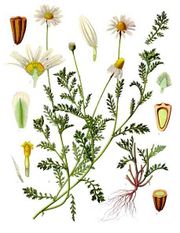Anthemis arvensis
| Anthemis arvensis subsp. var. | ||||||||||||||||||||||||||||||||||||||||||||||||||||||||
|---|---|---|---|---|---|---|---|---|---|---|---|---|---|---|---|---|---|---|---|---|---|---|---|---|---|---|---|---|---|---|---|---|---|---|---|---|---|---|---|---|---|---|---|---|---|---|---|---|---|---|---|---|---|---|---|---|

|
|
| ||||||||||||||||||||||||||||||||||||||||||||||||||||||
| ||||||||||||||||||||||||||||||||||||||||||||||||||||||||
Anthemis arvensis, which is also known as Corn chamomile or Field Chamomile, (syn. Anthe-matricaria gruetteriana Asch., Matricaria inodora L., Tripleurospermum maritimum (L.) W.D.J.Koch subsp. inodorum (L.) Appleq.), is a species in the genus Anthemis of the Asteraceae family. In addition, this plant is used like a ornamental plant.
| Standard Cyclopedia of Horticulture |
|---|
|
Anthemis arvensis, Linn. Pubescent, not ill- scented: Lvs. rather coarsely 1-2 pin- nately parted: pappus a minute border: heads 1 in. or more across; the involucre with broad, blunt scarious marginal edges; rays pistillate, spreading, 2-tcothed. —Not common and rather coarse.
|
Cultivation
Propagation
Pests and diseases
Varieties
Gallery
-
photo 1
-
photo 2
-
photo 3
References
- Standard Cyclopedia of Horticulture, by L. H. Bailey, MacMillan Co., 1963
External links
- w:Anthemis arvensis. Some of the material on this page may be from Wikipedia, under the Creative Commons license.
- Anthemis arvensis QR Code (Size 50, 100, 200, 500)
